As usual, we wrap up the year with a report about the markets and our trading for the last twelve months (here’s a link to last year’s report). Having been involved in and trading the markets now for over 20 years, I have to say that this year was unique in many ways, most of them not really positive for trading. Volume and activity were way down in all three asset classes that we trade (stocks, futures, and Forex). Without action, it really takes a concentrated effort to get and stay green. Overall, I would say again that our flagship stock report performed admirably as usual, while Forex had a decent start to the year but really suffered as ranges dipped to extended historic lows. The futures also suffered from lack of range and volume, especially in the second half of the year.
I make the case often that I believe professional traders should be open to trading anything because things go through cycles, and this was certainly a year that would have challenged anyone trading only Forex or futures in my opinion, although the stock stuff had enough moments to make it the easier asset class to trade. We’ll get into some numbers at the back end, but let’s first look at what the market gave us.
The S&P 500 came into the year at 1257.60 and closed at 1426.19 after once again spending a lot of time on the critical ES level of 1312.50 (an old Tradesight joke from the last decade, as is the EURUSD at 1.2737). That’s a 13% gain on the S&P for the year, which is certainly nothing to sneeze at. Here’s the chart, though, which shows that we didn’t have nearly the up and down swings that we are used to:
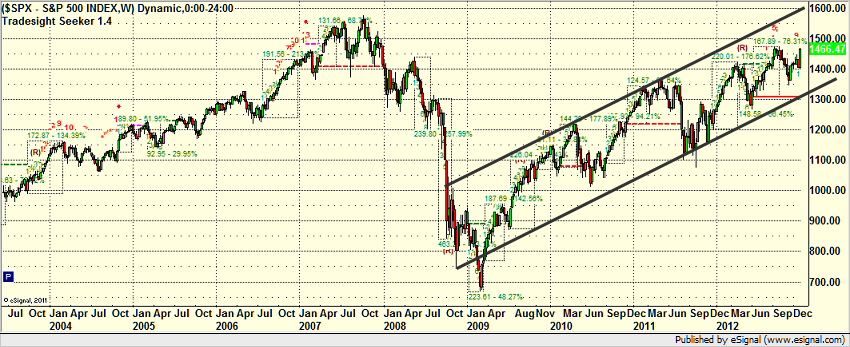
And you can see that also by looking at the Volatility Index (VIX) for the year, which, for the first time in the last 5 years, never really got a spike over 40, which creates the pullbacks:
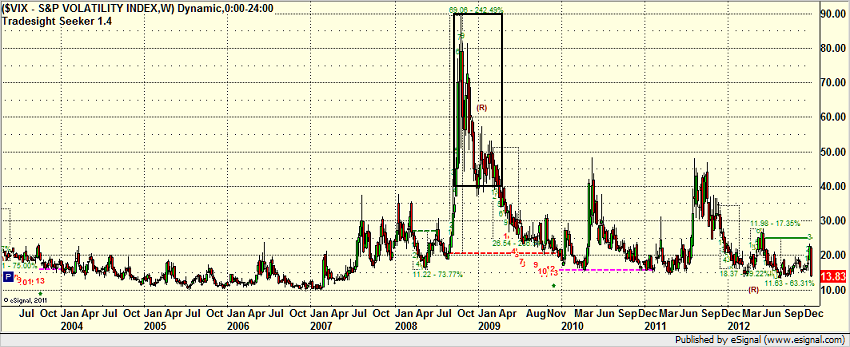
Even with all of the Fiscal Cliff concern, there was never really a drop in the market, and we went through an election with no issues. Also, I’m writing this a few days into 2013, and the market is up strong to start the year as well.
The NASDAQ came into the year at 2277 and closed at 2660, a 383 point gain, or 16.8%. Again, nothing to sneeze at for investors:
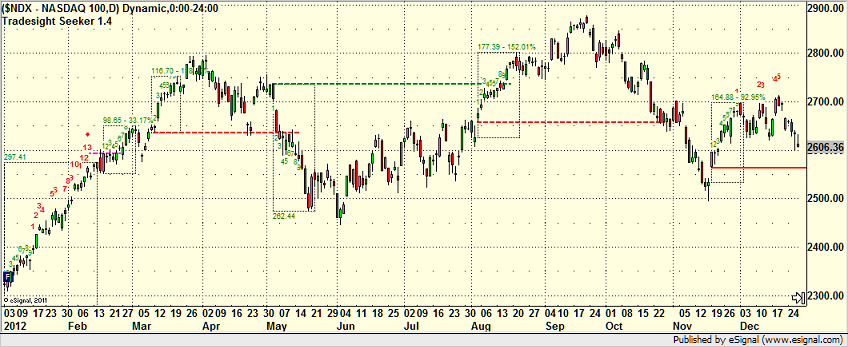
If you break out the two key tech sectors, the Semiconductors and Biotechs, you can see that the Bios had a decent year:
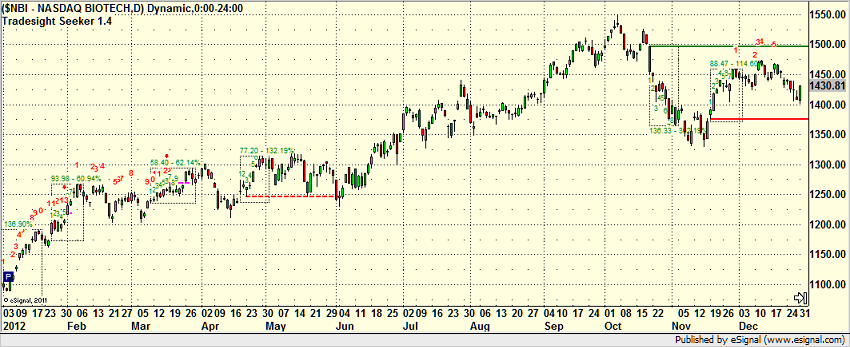
However, the Semis were actually down for the year at the midpoint (note that the low bar of the year is a 13 buy signal from our Seeker tool:
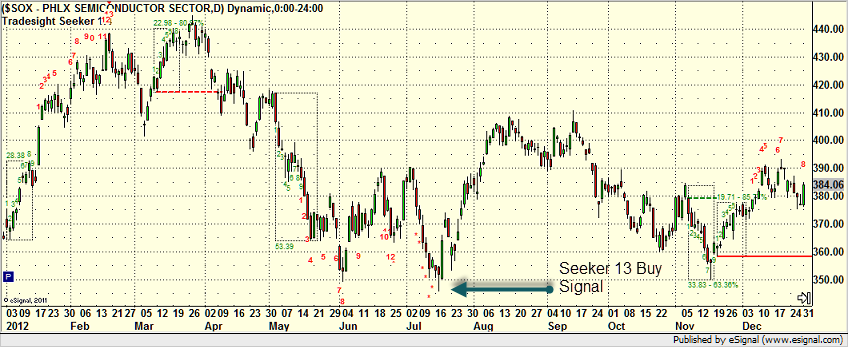
I’ve already written up a separate Forex end of year report, but for Forex traders, ranges were the problem, and overall movement wasn’t great either. Here’s the US Dollar Index, which basically traded flat in three boxes for most of the year:
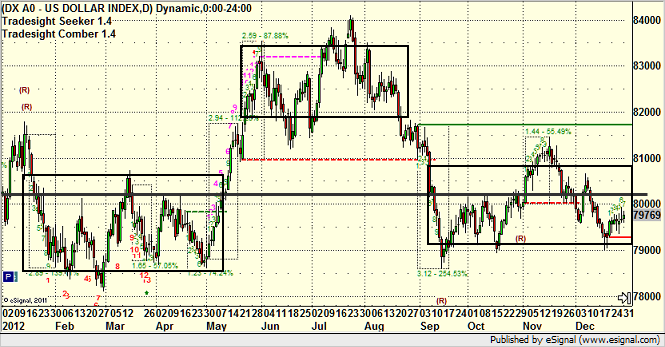
The EURUSD was in a smaller range than normal for annual numbers:
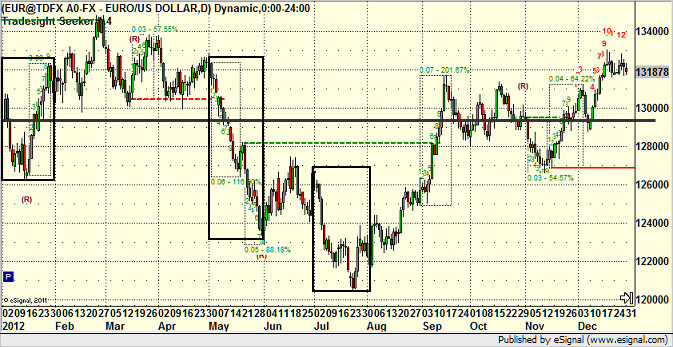
As was the GBPUSD:
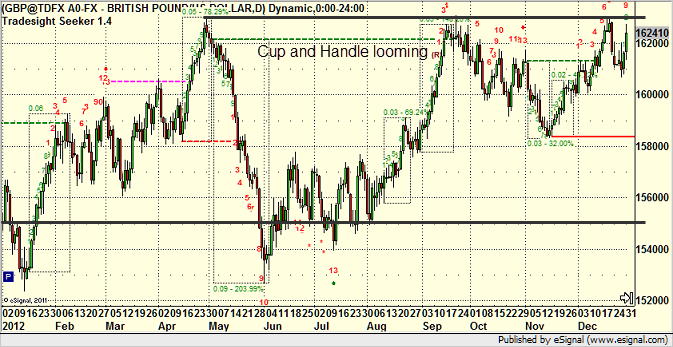
The USDJPY had impossibly narrow intraday moves, but on the whole, the US Dollar strengthened against the JPY for the year (even though it slightly weakened against other currencies):
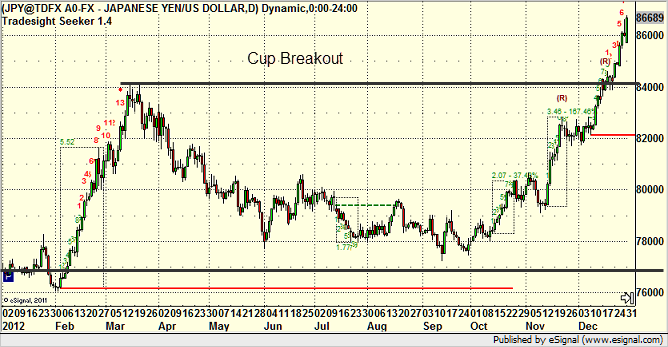
While 2011 saw the nuclear disaster in Japan (and the USDJPY has been pegged and tough to trade ever since), the last two years saw all of the issues out of Europe, including the failed austerity actions (failed meaning that the moves to cut spending has only raised unemployment and done nothing to help their respective economies), the potential (still looming) fracture of the Euro, and the self-created Fiscal Cliff mess that Congress set up for post-2012 election over a year ago.
All of those individuals added up to less economic activity, less movement of money, and a lot of uncertainty about taxes and where money was headed. It has also been a much stricter lending environment as the banks are still reeling from the 2008 debacle, and that hasn’t helped. Add it all up, and all of the markets were somewhat stuck in place.
Volume in the stock market is important for trading, and 2012 set an interesting record from the last FIFTEEN YEARS (this fact is extremely important but will be lost on many people). 2012 was the first time in 15 years that NASDAQ volume never saw a 10-day moving average get over 2 billion shares. Our general rule for good trading has always been that the 2 billion share “average” day or better volume is needed for the better sessions. We did have some days over 2 billion shares, but not many, and the 10 day moving average never got over that number, as you can see here:
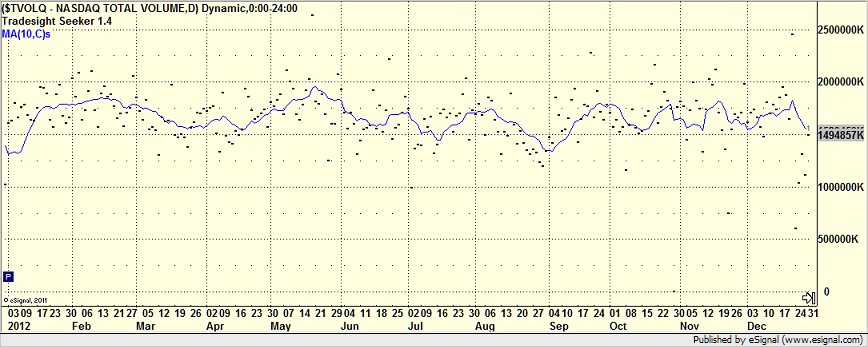
Compare that to even 2011, where the moving average spent almost half of the year above that level:
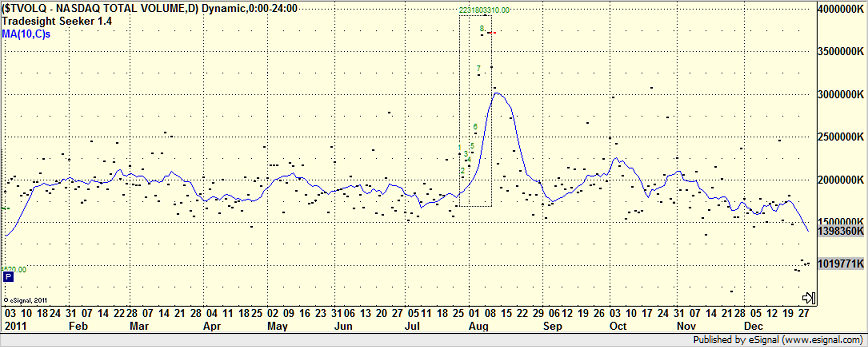
Or 2010, which is a year that is much more typical of what we have seen for a long time, where volume is well over 2 billion shares most of the year, except maybe the summer doldrums of August and the Holiday season of December:
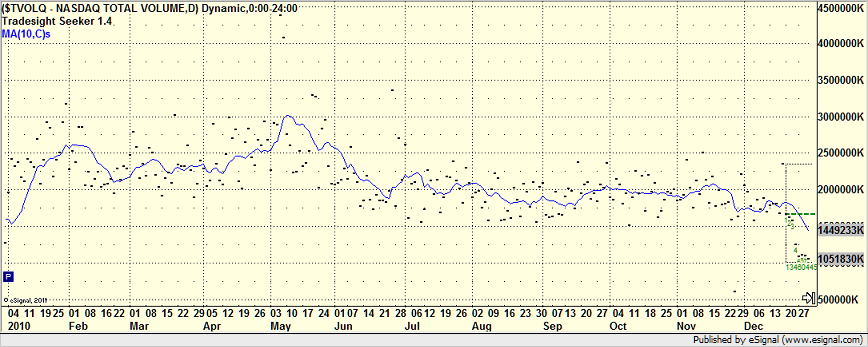
Easily, the single biggest contributor to the trading environment is the lack of volume, which means everything is moving less, and following through LESS, which is the most important point.
Another contributor to this, though, was the amount of “fast” money (i.e. daytrading money) that got “stuck” in Facebook on the IPO:
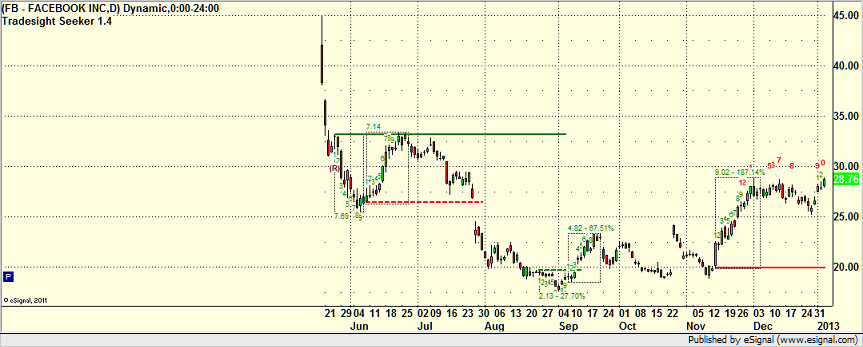
Again, one of the most poorly handled (except for for people working at Goldman) IPOs in history, and if you line up the biggest drop in market volume, it comes with the day that Facebook went public.
This was not a year that needed that to happen.
Here’s a look at oil, which declined for the year (and despite what some people might try to say, is down quite a bit from what we’ve seen on average the last few years):
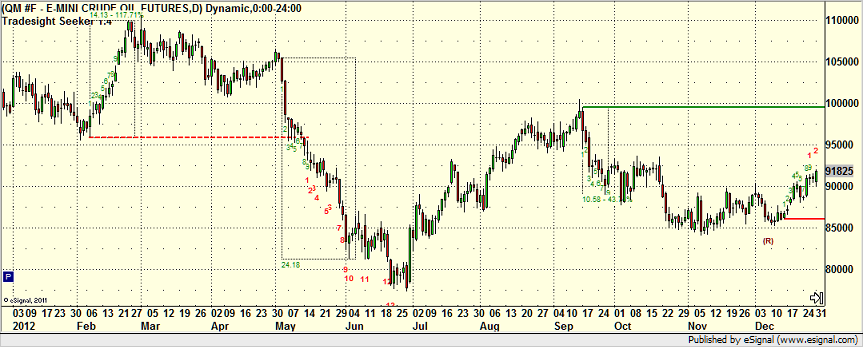
There are also some interesting points to be made about some of the bigger tech stocks that we trade frequently, such as AAPL, which had a strong early part of the year but sold off sharply late. It came into the year just over $400 and almost broke $500 in the December plunge, although you’ll notice that the Seeker again gave a 13 buy signal on the day that might have tried to break $500, and that has been the low so far (it is behaving like it will break it soon):
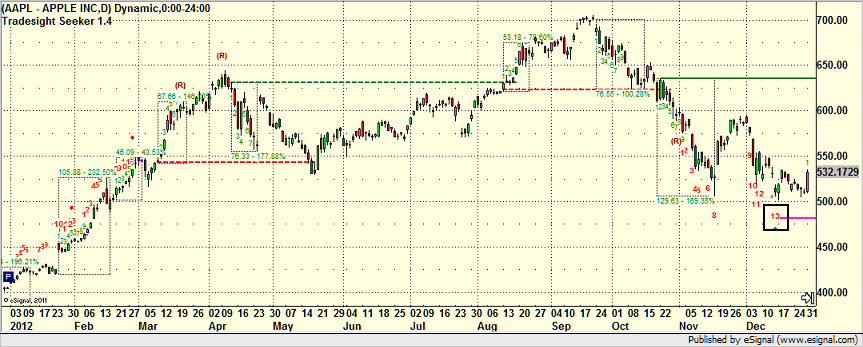
GOOG, on the other hand, had a slower start to the year, but clearly came on stronger in the second half as it continues to see better Android sales than iStuff sales, especially in other countries:
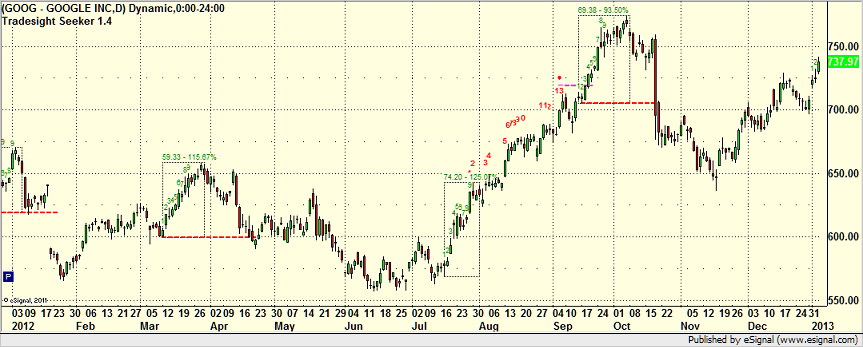
AMZN, another favorite trading stock of ours, had a strong year and held it:
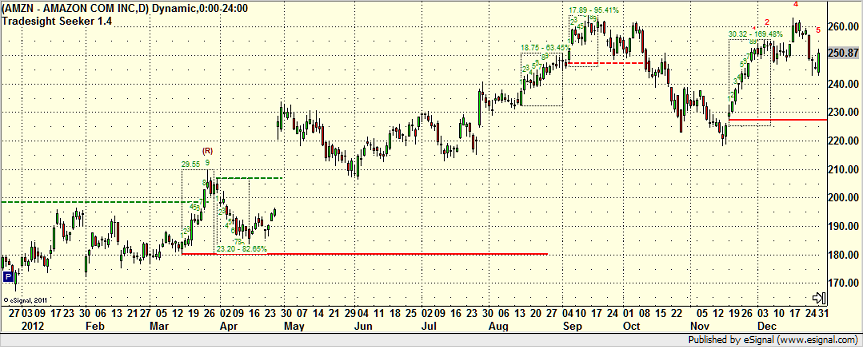
And finally, let’s put a few more things into longer term perspective. Here’s the 8-year chart of the NDX, which now makes the 2008 banking collapse look like a blip, but I’ve marked it up with the high in 2007 when oil first closed over $80 (when Tradesight predicted bad things were coming) and the recent post-stimulus trendline, which started in early 2009 and tested as recently as September. This is a line we’re going to want to watch if the looming “battle” in 60 days leads to too much in spending cuts (“austerity”), which will most likely put the recovery on hold and hurt the markets:
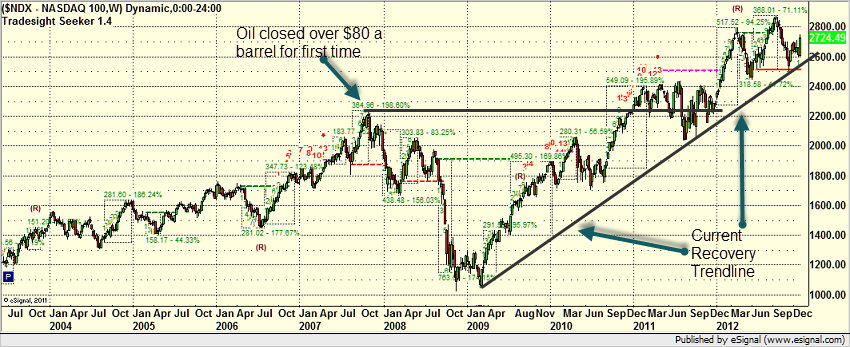
Here’s the S&P over the same period, which hasn’t yet reclaimed the highs of 2007 prior to the collapse, but is clearly in a “channel” that we can monitor:

And finally, here’s the VIX over 8 years. You can’t do a year-end report without showing the importance of the VIX or Rich will get mad:

Remember that the VIX over 40 usually means panic is setting in and a reversal is ready to happen. The spike to 90 and the period of 3 months that the VIX basically held over 40 in late 2008 on the collapse was historic, and at the time, what we said was that when it finally retreated under 40 (which happened in March 2009), that would a long term bottom in the markets. So far, that has proven extremely accurate, but it was also predicated on a lot of good economic decisions coming out of Washington. And certainly, we’ve made the money we wanted on that move. I’m not sure based on the actions out of Washington over the last 18 months or so that we can assume that good decisions will continue to be made, which can still derail the train. Keep in mind that the downgrade of US debt, if you read the report, was not because of our debt ratio or growth rate. It was because of a concern that Washington was suddenly so dysfunctional that it wouldn’t do the things that it has always done to show that the United States is the responsible leading financial player in the world (i.e. always pay our bills and don’t pretend that we wouldn’t).
With the Fiscal Cliff at least behind us (and if they had just done it back six months ago, things would have been a lot better the last six months for trading), we’re already seeing better volume and movement in the opening days of 2013. Unfortunately, they couldn’t get more than a 2 month extension on the sequester, so the spending battle looms and lines up with the debt ceiling increase (again, the more you suggest that the United States might NOT increase the debt ceiling, therefore might NOT pay our existing bills), the more it hurts the economy. And, just like everything these days, my expectation has to be (in terms of guiding traders) that Washington will take it right up to the last day again because they can’t put the country first. So, we will see how long the “better trading” environment that we are seeing signs of lasts before the market gets crippled again wondering how that will be resolved. If you want a better trading environment, call you Congressperson and let him/her know that they better put together a deal that lasts for several years so the market and the economy has certainty. Believe me, that’s more important that the DETAILS of the deal. We can’t keep going through this every 12 months.
So, in the context of that market environment during 2012, I think it is clear that stock trading was the better asset class. Every year, we have one, maybe two months that are losing months in Forex as ranges come and go. This was the first year (in the seven that we’ve been doing Forex) that we had THREE months IN A ROW even that had losses. That’s how bad ranges got.
Meanwhile, almost 70% of our stock trades that triggered with market support worked enough for a partial, which means that even though there were more than normal that didn’t do much beyond the partial, you shouldn’t lose money on those 70% of trades. And we still had plenty of big winners, all of which you can track daily in the Market Blog even if you aren’t a subscriber.
The futures were the middle ground. They still behaved technically, but I see a lot more false starts where a nice setups sweeps once and stops and then works at least to the partial the second time than we have seen in prior years. And that just creates a lot of whiplash and net-nothing days.
I do expect ranges to come back in Forex, and as we see stock market volume improve, Futures will see better action. Stocks, while fairly consistent, will get even better, with more trades following through, with market volume.
So, even though Santa has already come and gone for 2012, if you are asking for anything, ask for volume in the markets. Or better yet, don’t ask him, ask someone in Washington DC, as they are really the ones that can make it happen. But no, the stories you here about “regulation killed the Forex market forever” and “High Frequency Trading makes it impossible for retail traders to make money” are all nonsense. Economic activity will only grow over time on average.
Here’s to a great 2013, and thanks for being the best subscribers in the world.
